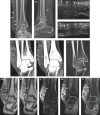Lipoma arborescens
- PMID: 24452971
- PMCID: PMC4291913
- DOI: 10.11622/smedj.2014003
Lipoma arborescens
Abstract
Lipoma arborescens is a chronic, slowly progressive intra-articular lesion characterised by villous lipomatous proliferation of the synovium, usually involving the suprapatellar pouch of the knee joint. It is an uncommon cause of intra-articular masses that presents as slowly progressive painless swelling of the joint, which persists for many years and is accompanied by intermittent effusions. We highlight this condition to raise awareness of its clinical spectrum and imaging features, so that early diagnosis and appropriate treatment can be given, and misinterpretation of this condition as other more complex intra-articular masses is avoided. This pictorial essay aims to provide a brief yet comprehensive review of the clinical features, distribution, morphological types and imaging characteristics of lipoma arborescens, including its common differential diagnoses and management.
Figures








References
-
- Hallel T, Lew S, Bansal M. Villous lipomatous proliferation of the synovial membrane (lipoma arborescens) J Bone Joint Surg Am. 1988;70:264–70. - PubMed
-
- Yan CH, Wong JWK, Yip DK. Bilateral knee lipoma arborescens: a case report. J Orthop Surg (Hong Kong) 2008;16:107–10. - PubMed
-
- Ryu KN, Jaovishida S, Schweitzer M, Motta AO, Resnick D. MR imaging of lipoma arborescens of the knee joint. Am J Roentgenol. 1996;167:1229–32. - PubMed
-
- Vilanova JC, Barceló J, Villalón M, et al. MR Imaging of Lipoma arborescens and the associated lesions. Skeletal Radiol. 2003;32:504–9. - PubMed
-
- Sheldon PJ, Forrester DM, Learch TJ. Imaging of intraarticular masses. Radiographics. 2005;25:105–19. - PubMed
Publication types
MeSH terms
LinkOut - more resources
Full Text Sources
Other Literature Sources

